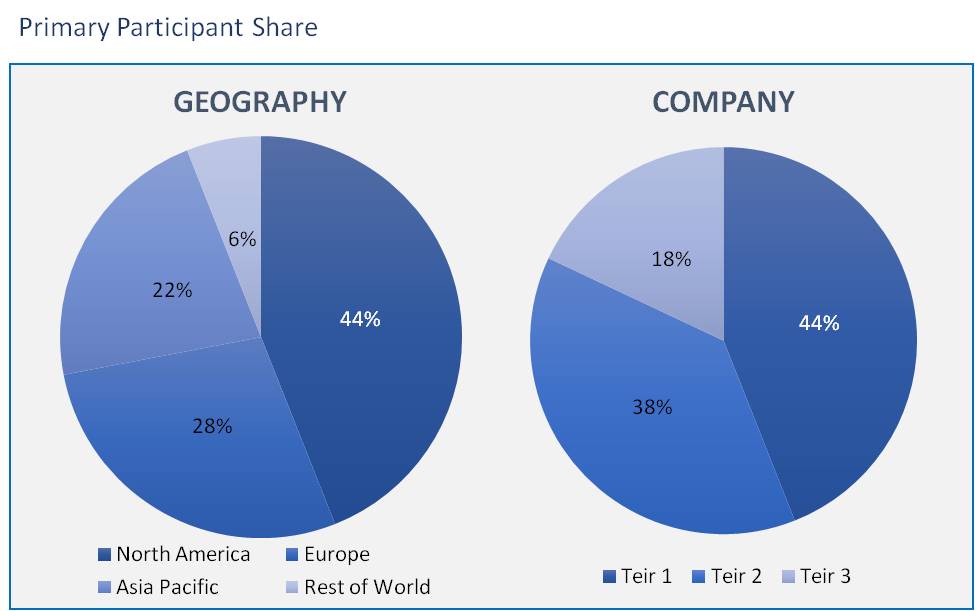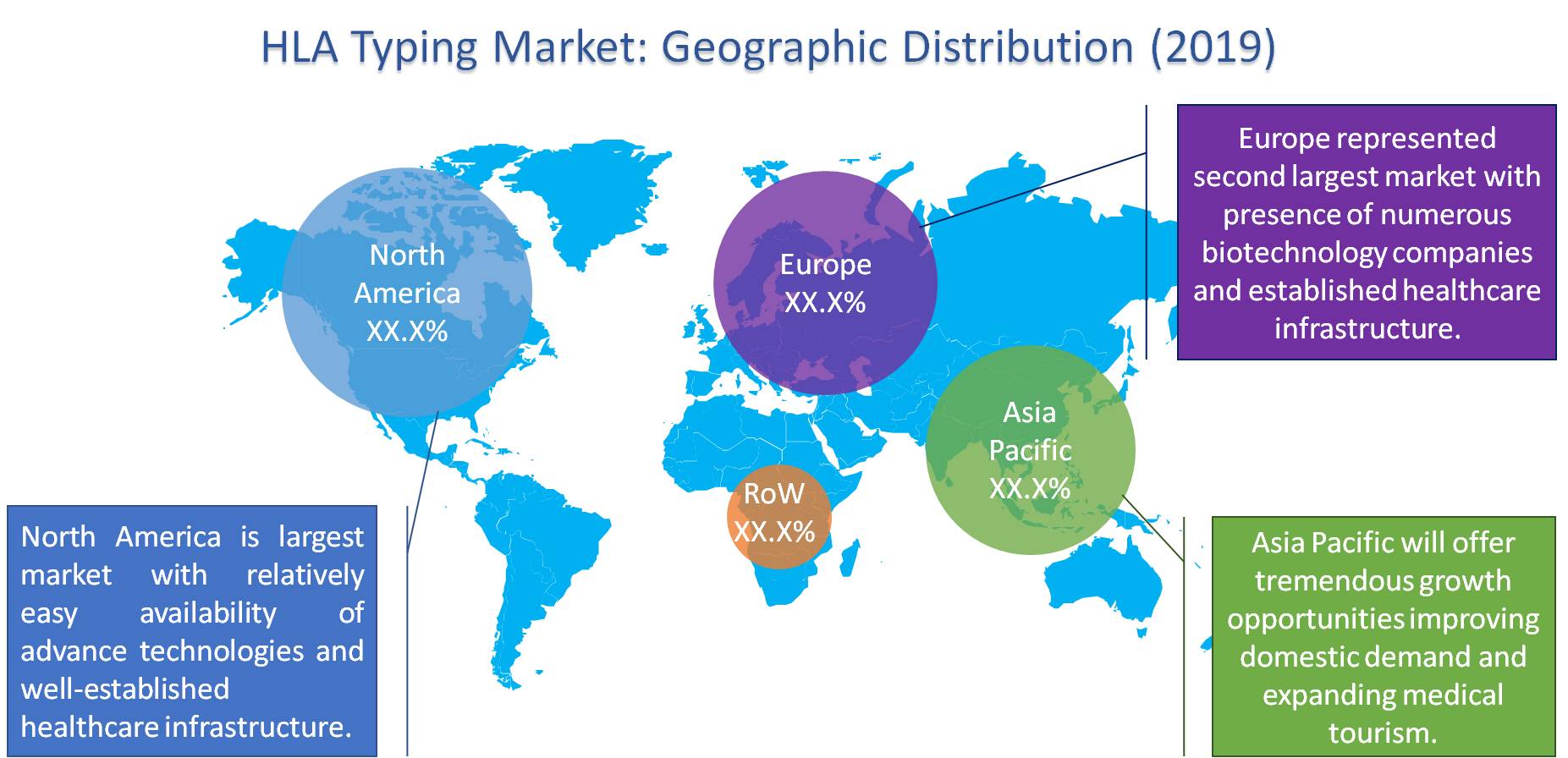
HLA Typing Market By Product (Reagents & Consumables, Instruments, Software & Services), By Technology (Molecular Assay Technologies and Non-Molecular Assay Technologies), By Application (Diagnostic Applications and Research Applications), By End-Users (Independent Reference Laboratories, Hospitals & Transplant Centers, Research Laboratories & Academic Institutes), Geography (North America, Europe, APAC, RoW) - Global Forecast up to 2026
- July, 2020
- Domain: Healthcare - Biotechnology
- Get Free 10% Customization in this Report
HLA (Human Leukocyte Antigen) Typing is a kind of genetic test conducted to check individual differences in an immune system of the person. This test is important to identify whether a person is capable to safely donate bone marrow, cord blood, or any other organ to any person who is in need of a transplant. There is a rapid growth in the demand for transplant diagnostic products due to factors such as public and private increased funding in target research activities. Majorly the increase in certain diseases such as blood cancers, genetic blood disorders where stem cell transplantation is required, this situation is expected to drive the HLA Typing market. However, the limited reimbursements for target procedures are a restrain for this market. The HLA typing market is expected to reach USD 990.12 million by 2026 from USD 659.75 million in 2020, at a CAGR of ~7.0%.
Research Methodology:
The HLA typing market has been analyzed by utilizing the optimum combination of secondary sources and in-house methodology, along with an irreplaceable blend of primary insights. The real-time assessment of the market is an integral part of our market sizing and forecasting methodology. Our industry experts and panel of primary participants have helped in compiling relevant aspects with realistic parametric estimations for a comprehensive study. The participation share of different categories of primary participants is given below:

The scope of the HLA Typing market is defined in the segmentation includes:
By Product and Service:
- Reagents & Consumables
- Instruments
- Software & Services
By Technology:
- Molecular Assay Technologies
- PCR-Based Molecular Assays
- Sequence-specific oligonucleotide-PCR
- Sequence-specific primer-PCR
- Real-time PCR
- Other PCR-based molecular assays
- Sequencing-Based Molecular Assays
- Sanger sequencing
- Next-generation sequencing
- Other sequencing-based molecular assays
- Sequencing-Based Molecular Assay
- Non-Molecular Assay Technologies
By Application:
- Diagnostic Applications
- Antibody Screening
- Chimerism Monitoring
- Other Applications
- Research Applications
By End User:
- Independent Reference Laboratories
- Hospitals & Transplant Centers
- Research Laboratories & Academic Institutes
By Region:
- North America
- Europe
- APAC
- Rest of World
The global HLA (Human Leukocyte Antigen) Typing market is segmented based on end-user. The segment of independent reference laboratories accounted for the largest share in the market due to the increased demand for organ transplant procedures, improved and automated diagnostic laboratories, increasing research and development activities outsourced by pharmaceutical and biotechnology companies to independent reference laboratories.
The global HLA Typing market is segmented based on end-user. The independent reference laboratories segment, which accounted for the largest share in the market with increased demand for organ transplant procedures, improved and automated diagnostic laboratories, increasing research and development activities outsourced by pharmaceutical and biotechnology companies to independent reference laboratories.
Further, HLA Typing market segmentation based on product and service includes Reagents & Consumables, Instruments, software & services. In this market segment, reagent and consumables play a major role in the market growth because of the early patient profiling during organ transplantation.
Based on technology, the market is divided into molecular assay technologies and non- molecular technologies. By analysis, the molecular assay technology has the majority of the demand in the HLA typing. The molecular assay technology consumes less time as compared to other technology and gives effective results that support market growth.
Moreover, the HLA Typing market based on region is segmented into four regions, including North America, Europe, Asia Pacific, and RoW. Further, the North America region is accounted for the largest share of the transplant market due to the well-developed market for medical devices, highly improvised healthcare system, a rapid increase in the adoption of the innovative transplant diagnostic technologies.

Globally, the HLA Typing market is growing at a CAGR of ~7.0% during the forecast period of 2020-2026. The factors which are majorly driving this market are innovative technologies in the transplant procedures and increasing transplant procedures, a large number of research and development activities in this field of HLA Typing. Molecular tests include high expenses for the HLA typing test, which is standing as a constraint in this market.
Globally HLA Typing market is playing a major role in the transplant diagnostic field, giving an accurate analysis of the person’s immune system for further transplantation process. An increase in the adoption of cross-matching and chimerism testing during post and pre-transplantation gives the opportunity in the market. However, due to the number of donors compared to donor accepters are very less, the market is facing a major challenge in the growth of the market.
Some of the prominent players in the HLA Typing Market are Thermo Fisher Scientific, Inc., Omixon, CareDx, Inc, QIAGEN N.V., Luminex, Biofortuna, Illumina, Bio-Rad Laboratories, Inc., Takara Bio, TBG Diagnostics Ltd., and F. Hoffman-La Roche Ltd.
Moreover, the awareness about organ donation and transplantation across the developing countries and emerging technologies are supporting the HLA Typing Market growth globally. This report will enable the market players to understand the key market trends, market dynamics, and critical needs of the end-users. The qualitative and quantitative analysis covered in the study would enhance the user utility of the report.
- The competitive analysis of the major players enables users to understand the dynamic strategies such as product innovation, partnerships, merger & acquisitions and joint ventures of the key players
- This report also provides the portfolio analysis, capability analysis of the leading players
- The report will also help the research organization of HLA Typing market to support their development activities
- Quantitative analysis of the market enables users to understand the actual facts of the market across four major regions
1. Executive Summary
2. Industry Outlook
2.1. Industry Overview
2.2. Industry Trends
3. Market Snapshot
3.1. Market Definition
3.2. Market Outlook
3.3. PEST Analysis
3.4. Porter Five Forces
3.5. Related Markets
4. Market characteristics
4.1. Market Evolution
4.2. Market Trends and Impact
4.3. Advantages/Disadvantages of Market
4.4. Regulatory Impact
4.5. Market Offerings
4.6. Market Segmentation
4.7. Market Dynamics
4.7.1. Drivers
4.7.2. Restraints
4.7.3. Opportunities
4.8. DRO - Impact Analysis
5. Technology: Market Size & Analysis
5.1. Overview
5.2. Molecular Assay Technologies
5.3. Non-molecular Assay Technologies
6. Application: Market Size & Analysis
6.1. Overview
6.2. Diagnostic Applications
6.2.1. Antibody Screening
6.2.2. Chimerism Monitoring
6.2.3. Others
6.3. Research Applications
7. Product: Market Size & Analysis
7.1. Overview
7.2. Reagents & Consumables
7.3. Instruments
7.4. Software & Services
8. End User: Market Size & Analysis
8.1. Overview
8.2. Independent Reference Laboratories
8.3. Hospitals & Transplant Centers
8.4. Research Laboratories & Academic Institutes
9. Geography: Market Size & Analysis
9.1. Overview
9.2. North America
9.3. Europe
9.4. Asia Pacific
9.5. Rest of the World
10. Competitive Landscape
10.1. Competitor Comparison Analysis
10.2. Market Developments
10.3. Mergers and Acquisitions, Legal, Awards, Partnerships
10.4. Product Launches and execution
11. Vendor Profiles
11.1. Thermo Fisher Scientific Inc.
11.1.1. Overview
11.1.2. Product Offerings
11.1.3. Geographic Revenue
11.1.4. Business Units
11.1.5. Developments
11.1.6. SWOT Analysis
11.1.7. Business Strategy
11.2. F. Hoffman-La Roche Limited
11.2.1. Overview
11.2.2. Product Offerings
11.2.3. Geographic Revenue
11.2.4. Business Units
11.2.5. Developments
11.2.6. SWOT Analysis
11.2.7. Business Strategy
11.3. Qiagen
11.3.1. Overview
11.3.2. Product Offerings
11.3.3. Geographic Revenue
11.3.4. Business Units
11.3.5. Developments
11.3.6. SWOT Analysis
11.3.7. Business Strategy
11.4. Immucor
11.4.1. Overview
11.4.2. Product Offerings
11.4.3. Geographic Revenue
11.4.4. Business Units
11.4.5. Developments
11.4.6. SWOT Analysis
11.4.7. Business Strategy
11.5. Abbott Laboratories Inc
11.5.1. Overview
11.5.2. Product Offerings
11.5.3. Geographic Revenue
11.5.4. Business Units
11.5.5. Developments
11.5.6. SWOT Analysis
11.5.7. Business Strategy
11.6. Luminex
11.6.1. Overview
11.6.2. Product Offerings
11.6.3. Geographic Revenue
11.6.4. Business Units
11.6.5. Developments
11.6.6. SWOT Analysis
11.6.7. Business Strategy
11.7. Biofortuna
11.7.1. Overview
11.7.2. Product Offerings
11.7.3. Geographic Revenue
11.7.4. Business Units
11.7.5. Developments
11.7.6. SWOT Analysis
11.7.7. Business Strategy
11.8. Omixon
11.8.1. Overview
11.8.2. Product Offerings
11.8.3. Geographic Revenue
11.8.4. Business Units
11.8.5. Developments
11.8.6. SWOT Analysis
11.8.7. Business Strategy
11.9. Creative Biolabs
11.9.1. Overview
11.9.2. Product Offerings
11.9.3. Geographic Revenue
11.9.4. Business Units
11.9.5. Developments
11.9.6. SWOT Analysis
11.9.7. Business Strategy
11.10. Tbg Diagnostics Limited
11.10.1. Overview
11.10.2. Product Offerings
11.10.3. Geographic Revenue
11.10.4. Business Units
11.10.5. Developments
11.10.6. SWOT Analysis
11.10.7. Business Strategy
12. Companies to Watch
12.1. Caredx, Inc.
12.1.1. Overview
12.1.2. Market
12.1.3. Business Strategy
12.2. Illumina
12.2.1. Overview
12.2.2. Market
12.2.3. Business Strategy
12.3. Bio-Rad Laboratories
12.3.1. Overview
12.3.2. Market
12.3.3. Business Strategy
12.4. Alpha Biotech, Ltd.
12.4.1. Overview
12.4.2. Market
12.4.3. Business Strategy
12.5. Gendx
12.5.1. Overview
12.5.2. Market
12.5.3. Business Strategy
12.6. Histogenetics Llc
12.6.1. Overview
12.6.2. Market
12.6.3. Business Strategy
12.7. Pacific Biosciences of California, Inc.
12.7.1. Overview
12.7.2. Market
12.7.3. Business Strategy
12.8. Hansa Biopharma Ab
12.8.1. Overview
12.8.2. Market
12.8.3. Business Strategy
12.9. Bag Healthcare
12.9.1. Overview
12.9.2. Market
12.9.3. Business Strategy
12.10. Takara Bio
12.10.1. Overview
12.10.2. Market
12.10.3. Business Strategy
13. Analyst Opinion
14. Annexure
14.1. Report Scope
14.2. Market Definitions
14.3. Research Methodology
14.3.1. Data Collation and In-house Estimation
14.3.2. Market Triangulation
14.3.3. Forecasting
14.4. Report Assumptions
14.5. Declarations
14.6. Stakeholders
14.7. Abbreviations
Research Framework
Infoholic research works on a holistic 360° approach in order to deliver high quality, validated and reliable information in our market reports. The Market estimation and forecasting involves following steps:
- Data Collation (Primary & Secondary)
- In-house Estimation (Based on proprietary data bases and Models)
- Market Triangulation
- Forecasting

Market related information is congregated from both primary and secondary sources.
Primary sources
involved participants from all global stakeholders such as Solution providers, service providers, Industry associations, thought leaders etc. across levels such as CXOs, VPs and managers. Plus, our in-house industry experts having decades of industry experience contribute their consulting and advisory services.
Secondary sources
include public sources such as regulatory frameworks, government IT spending, government demographic indicators, industry association statistics, and company publications along with paid sources such as Factiva, OneSource, Bloomberg among others.
